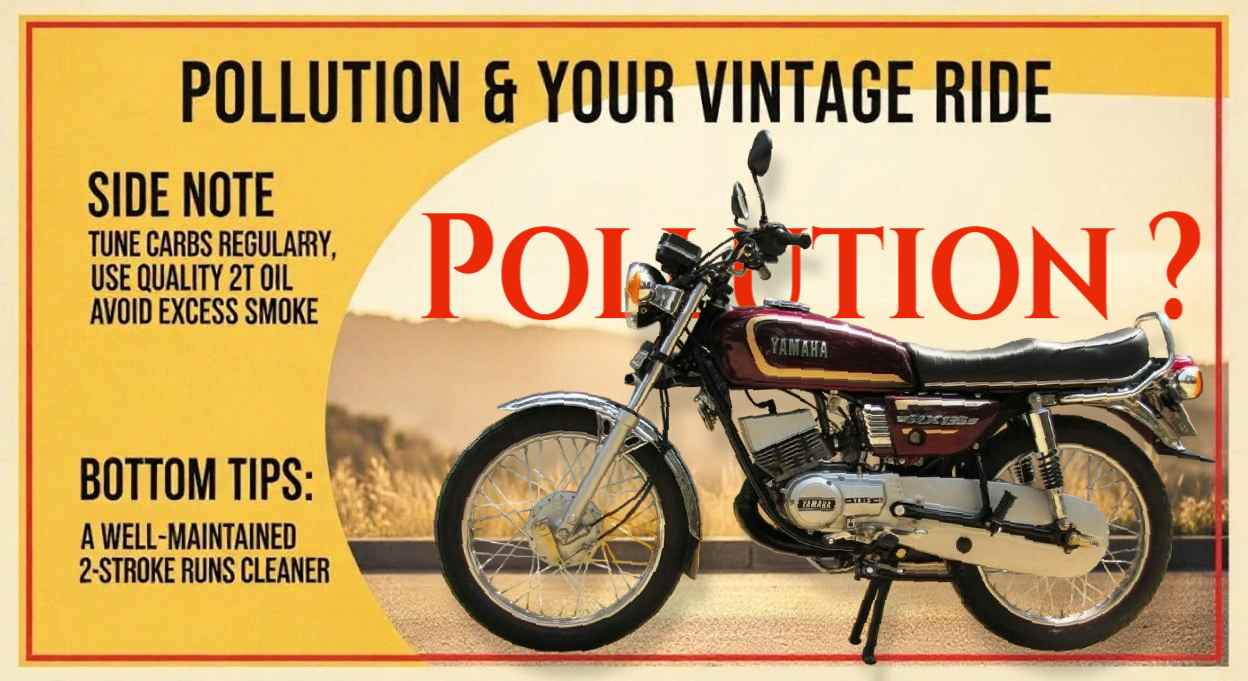- Posted on
- • Reviews
Why Two-Stroke Mopeds Emit 125× More Pollution (and What It Means for Your Health)
- Author
-
-

- User
- Torque
- Posts by this author
- Posts by this author
-

Two-Stroke Mopeds: The 125× Pollution Problem—and Why It Matters
What makes two-stroke mopeds so polluting?
Two-stroke mopeds burn a mix of petrol and oil. That oil doesn't fully combust, so the exhaust carries unburned hydrocarbons, benzene, polycyclic aromatic hydrocarbons (PAHs), and ultrafine particles. In controlled tests, two-stroke scooters emitted ~124× more volatile organic compounds (VOCs) at idle than other vehicle classes, with benzene spikes up to ~300,000 µg/m³ (≈146 ppm) measured right at the tailpipe—a level that's startling when you picture people idling in dense traffic at a red light.
The peer-reviewed study behind that headline finding concluded that, in some Asian cities, two-stroke scooters can contribute ~60–90% of roadside primary particulate matter despite consuming roughly ~10% of the fuel—a classic case of "asymmetric pollution."
The "125× pollution" claim, explained
Numbers vary by test cycle and pollutant, but here's the gist:
VOC emissions at idle: ~124× higher for two-stroke scooters vs. modern vehicle classes in lab tests. That's where the "~125×" phrasing comes from.
Benzene: Acute tailpipe concentrations at idle reached ~300,000 µg/m³ (≈146 ppm) in measurements, far above typical occupational short-term limits.
Primary organic aerosol & smog precursors: Two-stroke exhaust is rich in aromatic VOCs that form secondary organic aerosol (SOA)—a key urban haze component.
Takeaway: the "125×" figure isn't a blanket for every pollutant in every condition, but for VOCs at idle, it's well supported by lab work from the Paul Scherrer Institute published in Nature Communications.
Health risks you can't see (but breathe)
Ultrafine particles (UFPs) deeply penetrate lungs. Field studies on European bike paths found two-stroke mopeds driving sharp UFP peaks and contributing up to ~19% of total UFPs along routes—right where cyclists breathe hardest.
PAHs & VOCs: Two-strokes emit PAHs linked with cancer and cardiopulmonary disease; benzene exposure is a known carcinogenic risk.
Neighborhood exposure rises at idle and low-speed stop-and-go, exactly the conditions common to congested streets and school zones.
Why are two-strokes worse than four-strokes?
Two-strokes scavenge the cylinder by flushing fresh air-fuel mix through ports. Some of that mix—and the lubricating oil—escapes unburned into the exhaust. Result: higher CO, total hydrocarbons, PM, and toxics per kilometer than comparable four-strokes or fuel-injected systems, even when two-strokes pass basic regulatory tests.
Real-world policy signals (India & beyond)
India has long targeted high-emitting two-stroke fleets, e.g., Delhi halted registrations of two-stroke autorickshaws in 2002; Kolkata phased them out later.
New Delhi's draft 2025 proposals go further—pushing rapid two-wheeler electrification and placing stricter curbs on fossil two-wheelers from April 1, 2027 (pending finalization). Expect accelerated turnover from legacy two-strokes to EVs or cleaner four-strokes.
Pros and cons of two-stroke mopeds
Pros (why people love them):
Light, zippy, simple mechanics; easy to fix.
Classic sound/feel and low purchase cost for older models.
Cons (why cities don't):
Very high VOC/HC and particle emissions, especially at idle/low load.
Toxic species (benzene, PAHs) with clear health links.
Disproportionate roadside impact relative to fuel share.
Fun facts (that aren't so fun)
Some cities that banned two-stroke scooters saw lower roadside VOCs than nearby cities where they were still allowed—despite higher overall traffic in the stricter city.
Lab work shows moped PM mass can rival small diesel vehicles, but the particle chemistry is oil-rich, changing toxicity and aging behavior in air.
Practical fixes: how riders & cities can cut the harm
For riders/owners:
Switch to modern four-strokes or electric scooters if possible; the emissions drop is enormous.
If you must keep a two-stroke: correct oil ratio, quality 2T oil, fresh rings/reed valves, unclogged exhaust, and no premix "over-oiling." These steps won't make it clean, but they reduce visible smoke and HC.
For cities/policymakers:
Targeted inspection & maintenance for two- and three-wheelers; retire the worst super-emitters first.
Incentives for EV two-wheelers and low-interest swaps for delivery fleets.
Low-emission zones on bike corridors and school areas where UFP exposure is highest.
Frequently asked (smart) questions
Q: If a two-stroke passes a local emissions test, isn't it fine?
A: Not necessarily. Many tests don't capture idle or transient UFP spikes, where two-strokes misbehave most. Field and lab evidence shows outsized VOC/UFP events under real conditions.
Q: Is synthetic oil the fix?
A: Better oil helps reduce deposits and some smoke, but combustion-cycle losses remain. The core issue is engine architecture, not just oil quality.
Q: Are modern direct-injection two-strokes cleaner?
A: They can be much cleaner than carbureted two-strokes, but widespread moped-class DI is rare; most legacy fleets are carb + premix/oil-pump.
Bottom line
Two-stroke mopeds punch far above their weight in urban pollution. The "~125×" figure refers to VOCs at idle from lab tests and shouldn't be copy-pasted to every pollutant—but it accurately signals extreme emissions relative to modern vehicles. If your city cares about roadside air and cyclist/pedestrian health, fast turnover to four-stroke or electric, plus inspection of the dirtiest two-strokes, delivers quick wins.
